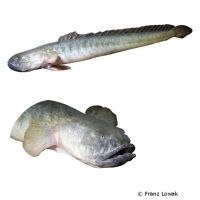Violet Goby (Gobioides broussonnetii)
| Violet Goby Gobioides broussonnetii | |
|---|---|
| Name | Violet Goby |
| Name Lat. | Gobioides broussonnetii |
| Family | Gobies |
| Family lat. | Gobiidae |
| Order | Gobies |
| Order lat. | Gobiiformes |
| Origin | America, Caribbean |
| Habitat | Estuaries |
| Diet | Omnivore |
| pH | 7.5-8.5 |
| Behavior | Semi-aggressive |
| Keeping | Pair, harem |
| Care Level | Experts only |
| Reproduction | Oviparous |
| Breeding | None reported |
| Life Span | 10-12 years |
| Protection | No |
| Metric Units | |
| Size | 50 cm |
| Temperature | 22-26 °C |
| Hardness | 10-25 °dH |
| Aquarium | 800 l |
| US Units | |
| Size | 20" |
| Temperature | 72-79 °F |
| Hardness | 178-445 ppm |
| Aquarium | 200 gal |
Distribution and habitat
Purple eel gobies are widespread in the western Atlantic, from the south of the USA through Central America to the southeast of South America, as well as in the Caribbean Islands. There they live in the intertidal zone of river mouths (estuaries) with muddy-soft bottoms, where they usually stay burrowed or hidden in their living caves during the day.
Maintenance
The aquarium should have a deep, diggable substrate of fine gravel or sand, with bottom hiding places (living caves) made of stacked round river stones, roots and tubes. Shaded lighting and a weak current is ideal.
There should be no detectable ammonia, ammonium and nitrite, the nitrate value should not exceed 100 mg/l. To ensure the water quality and oxygen content, a filter and heater adapted to the aquarium size is required, as well as lighting for the species-appropriate day-night rhythm of the animals.
Diet
In nature they feed mainly on carrion and plant remains (detritus). The food supply consists of Tubifex, Artemia, mosquito larvae etc., which is also accepted in frozen form without any problems. In addition, they regularly require plant food, such as commercially available algae leaves and high-quality sinking dry food (granules, crisps, tablets) with high plant content (spirulina, kelp).
Only feed as much as is eaten immediately (in a maximum of 10 minutes). A regular and varied diet promotes health and increases resistance
Behaviour and compatibility
The males are territorial and should only be kept together with one or more females. They behave peacefully towards other fish, even small ones. They can be socialized with other peaceful brackish water fish. Keeping several males is only recommended in a larger and richly structured tank.
Basically, only compatible fish species with similar demands on water quality and water temperature may be socialized.
Sex dimorphism
The sexes are difficult to distinguish. With some experience, the sexes can be distinguished by their genital papilla, which is pointed in the male and dull and yellowish in the female.
Reproduction and breeding
There are no known reports of successful breeding in the aquarium.
Important
Permanent keeping is possible only in brackish water with a salinity of 10-30 ‰.
Each animal needs at least one living cave, which is sometimes left during the day in shaded tanks.
The purple eel goby is often confused with the blue eel goby (Gobioides peruanus), which also lives in freshwater.
The well-being of the fish should be monitored regularly. Temperature should be checked daily, pH, hardness and nitrate levels at least every 14 days. Regular partial water changes are recommended, even if the contaminant level has not yet reached the upper limit. Sudden changes in water quality should be avoided. Newly introduced fish must be accustomed slowly to the water in the aquarium.
Further literature can be found in your pet store.
References
Text: Werner Winter; Image: Franz Lowak
Source: BMELV (1998): Tierschutzgutachten - Haltung von Zierfischen (Süßwasser); BAENSCH & RIEHL (2004): Aquarien Atlas Bd. 2, Mergus Verlag; ENGELMANN (2005): Zootierhaltung - Tiere in menschlicher Obhut: Fische, Verlag Harri Deutsch
- Gemäß § 21 Abs. 5 Tierschutzgesetz idgF
